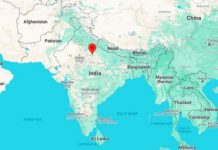
EVANSVILLE, Ind., Sept. 3 (UPI) — High financial stress and subpar harvest conditions this fall could lead to more injuries and deaths among farmers in the coming months, farm safety experts warn.
The concern is that crops were planted late in most places because of a historically wet Midwestern spring. Crops that are planted late must be harvested late, so farmers will have a small window of time to get their grains out of the field.
“When you’re under pressure, and people are sleep deprived, they’re working long hours under stress, and that’s when mistakes are made,” said Diane Rohlman, a professor of occupational and environmental health at the University of Iowa.
Adding to that stress this year, many farmers are entering fall harvest under undue stress from losing money on their crops for a second consecutive year, Rohlman added.
Farming is one of the most dangerous industries in terms of accidental injuries and deaths. In 2017, 258 farmers and ranchers died in work-related accidents, making it the eighth most dangerous job in the country, according to the Bureau of Labor Statistics. Most of those accidents involved transportation.
“They can be tractor rollovers,” Rohlman said. “It could be equipment they’re using, like a hay baler. People can get entangled and pulled into the equipment. Someone could be run over by a tractor.”
Experts like Rohlman and her counterparts in other Midwestern states are urging farmers to take breaks during this harvest, be diligent about safety precautions and watch out for other farmers.
“We’re going to hit cold weather and everybody is going to be working day and night,” Fred Whitford, a clinical engagement professor at Purdue University, told the farm journal AgWeb.
“Guys will push themselves to the max, and we have to realize that is when people get hurt or killed,” he said. “I bet 90 percent of these accidents could have been stopped, but we were worn out and going too fast — weariness and high speed. Take a power nap for 20 minutes out of the day, and be aware who is driving your vehicles.”
A rushed harvest is not the only safety concern experts say this fall crop will bring. The other issue is related to storage, said Jeff Adkisson, a board member on the Grain Feed Handling Safety Council.
Grains need to be relatively free from moisture to store well over the winter, Adkisson said. If they are not, they can stick together — forming clumps that block the opening, sticking together in a “bridge” at the top of the bin or solidifying into a large cylindrical column.
When that happens, farmers must enter the grain bin — often with a rod of some kind — to break up the grains.
“If you have a big column and you go in and poke it with a rod at the base, and the grain gives way, you can be covered up pretty quickly and not able to get out,” said Adkisson, who is also the executive vice president of the Grain and Feed Coalition of Illinois. “It would be a horrible death — a death by suffocation.”
Accidents and deaths in grain bins are fairly common around the Midwest. In 2018, 27 people died in grain bins, according to the Purdue University’s Agricultural Safety and Health Program.
The concern this fall is that because the Midwestern crop was planted so late, it likely won’t have time to fully dry in the field before cold weather necessitates harvest. That means much of this year’s stored grain is likely to clump together, forcing more farmers to enter their bins this spring.
“We just have a concern this year that the late planted crops may not fully mature and dry out in the field,” Adkisson said. “That could create problems.”





